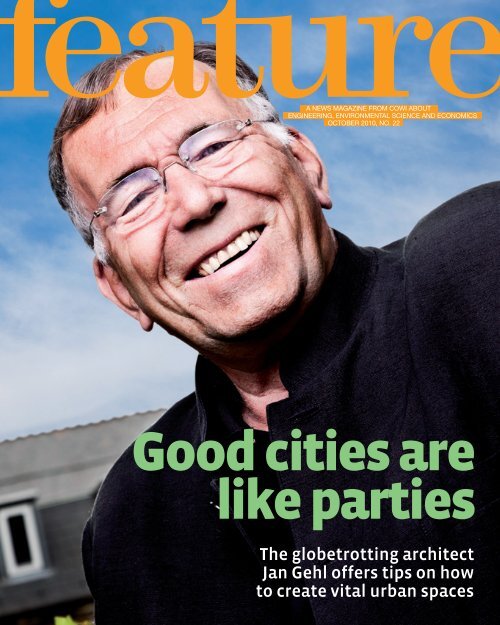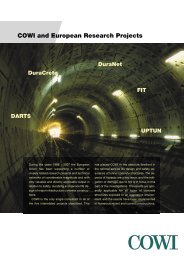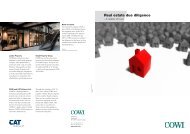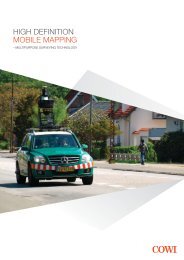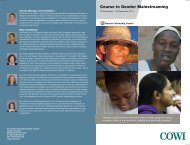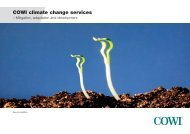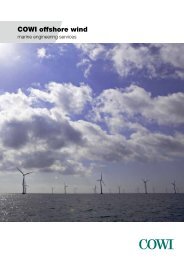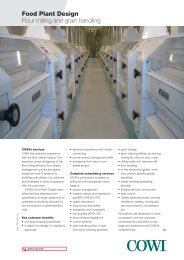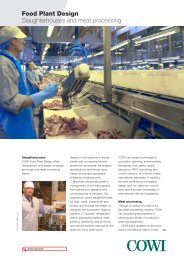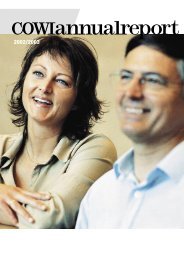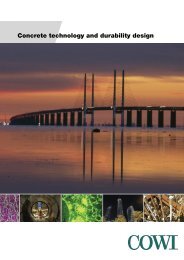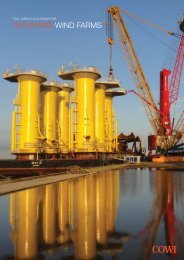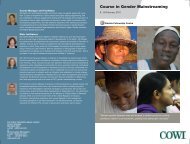You also want an ePaper? Increase the reach of your titles
YUMPU automatically turns print PDFs into web optimized ePapers that Google loves.
A NEWS MAGAZINE FROM COWI ABOUT<br />
ENGINEERING, ENVIRONMENTAL SCIENCE AND ECONOMICS<br />
OCTOBER 2010, NO. 22<br />
Good cities are<br />
like parties<br />
The globetrotting architect<br />
Jan Gehl offers tips on how<br />
to create vital urban spaces
A news mAgAzine from <strong>Cowi</strong> About<br />
engineering, enVironmentAL sCienCe And eConomiCs<br />
oCtober 2010, no. 22<br />
A DAY IN<br />
THE LIFE<br />
OF A COWI SPECIALIST<br />
Software specialist Charlotte<br />
Hybschmann Jacobsen has retooled<br />
her shipbuilding skills and put <strong>the</strong>m<br />
to use for COWI<br />
18<br />
4 FROM A PEDESTRIAN’S POINT-OF-VIEW<br />
Architects Jan Gehl and Mette Mogensen agree:<br />
good cities are pedestrian-friendly cities.<br />
11 WATER CYCLE REINVENTED<br />
Sustainable solutions are needed to address cities’ growing<br />
demand for water.<br />
17 BLOGGERS REMIX CONCRETE<br />
Two cowi specialists have launched an interdisciplinary blog exploring<br />
ways to make concrete production more sustainable.<br />
20 HARVESTING FUEL FOR SWEDEN’S LORRIES<br />
Half of <strong>the</strong> diesel used by Europe’s heavy-duty traffic can be<br />
replaced with a by-product from <strong>the</strong> paper industry.<br />
Good cities are<br />
like parties<br />
The globetrotting architect<br />
Jan Gehl offers tips on how<br />
to create vital urban spaces<br />
26 A ROAD LESS BUMPY<br />
A specially modified Mercedes packed with laser sensors, GPS and a<br />
digital camera helps smooth out <strong>the</strong> bumps on bike lanes.<br />
29 PATCHING PEOPLE INTO THE GRID<br />
A Danish city is making smart energy nets everyone’s business.<br />
The city-party comparison<br />
is a favourite of architect<br />
Jan Gehl.<br />
Photo: Das Büro<br />
News magazine about engineering,<br />
environmental science and economics<br />
from COWI. Feature is published in<br />
Danish and in English. The magazine<br />
is distributed to customers, partners<br />
and employees.<br />
Editorial staff:<br />
Bo Øksnebjerg (editor-in-chief),<br />
boog@cowi.com<br />
Christina Tækker (editor), cht@cowi.com<br />
Uzi Frank, uzif@cowi.com<br />
Lotte Lykke Pedersen, llp@cowi.com<br />
Anja Fabech Jensen, afj@cowi.com<br />
Rewrite: Kevin McGwin, in-o<strong>the</strong>r-words<br />
Design and layout<br />
Josina W. Bergsøe, jwb@cowi.com<br />
Helle Martini, hmar@cowi.com<br />
Hanne Bjørn Nielsen, hbn@cowi.com<br />
Marianne Rom, mrom@cowi.com<br />
Mette Schou, msux@cowi.com<br />
Editorial input closed<br />
21 September 2010<br />
Reproduction is permitted with<br />
appropriate source references<br />
Print run: 6,000<br />
Production: Rosendahl-Schultz Grafisk<br />
ISSN 1903-8909<br />
Published by COWI A/S<br />
Parallelvej 2<br />
DK-2800 Kongens Lyngby<br />
Tel +45 45 97 22 11 Fax +45 45 97 22 12<br />
www.cowi.com<br />
COWI is a leading Nor<strong>the</strong>rn European<br />
consulting group. We provide state-of-<strong>the</strong>art<br />
services within <strong>the</strong> fields of engineering,<br />
environmental science and economics<br />
with due consideration for <strong>the</strong> environment<br />
and society. COWI is a leader within<br />
its fields because COWI's 6,000 employees<br />
are leaders within <strong>the</strong>irs.<br />
Behind <strong>the</strong> story<br />
A COWI photographer takes aim at one of <strong>the</strong> company’s<br />
Piper-Chieftains as it is towed from its hanger at Roskilde<br />
Airport in preparation for a mapping mission.<br />
Read more, page 36. Photo: Das Büro<br />
Hold <strong>the</strong> mercury, please<br />
Fish and o<strong>the</strong>r seafood could<br />
soon be safer to eat if a global<br />
mercury agreement is reached<br />
as expected<br />
34<br />
At home on <strong>the</strong><br />
30 GETTING SMART ABOUT POWER GRIDS<br />
In <strong>the</strong> future, heat and electricity customers will also be producers<br />
in two-way intelligent energy nets.<br />
36 CLEAR FOR TAKE-OFF<br />
cowi’s aerial cartographers need to keep <strong>the</strong>ir eyes on <strong>the</strong> sky<br />
as well as <strong>the</strong> terrain.<br />
COWI interns have collected 9,000 soil<br />
samples that will help give a better<br />
picture of how much<br />
CO2 RANGE<br />
CO2 is released by<br />
agricultural wetlands<br />
Locations represented in this issue of Feature:<br />
New York<br />
Iceland<br />
Norway<br />
Faroe Islands Sweden<br />
Denmark Lithuania<br />
Britain Germany<br />
Serbia<br />
12<br />
Japan<br />
China<br />
International news magazine from cowi • 3
Copenhagen’s Kartoffelrække (Potato Rows)<br />
neighbourhood has all <strong>the</strong> right elements for<br />
good urban living, according to Gehl.<br />
Architects Jan Gehl and<br />
cowi’s Mette Mogensen agree:<br />
people make good cities.<br />
But where do cars fit in<br />
Looking<br />
at cities at<br />
eye level<br />
By Eva Isager<br />
Cities are something like parties –<br />
people stay much longer than really<br />
necessary if <strong>the</strong>y are enjoying <strong>the</strong>mselves.<br />
Think of Venice or New York.<br />
Or <strong>the</strong> waterfront in Oslo. They are<br />
all places where you can experience<br />
<strong>the</strong> city happening all around you<br />
as you stroll idly by. The truth, however,<br />
is that over <strong>the</strong> past 50 years,<br />
many cities have slowly been<br />
drained of <strong>the</strong>ir vitality. Traffic congestion,<br />
high-rises and sprawling<br />
lawns have forced out <strong>the</strong> plazas<br />
and squares where people once<br />
congregated.<br />
The city-party comparison is a<br />
favourite of architect Jan Gehl. A<br />
pioneer in efforts to reclaim cities for<br />
humans, his influence is unmatched<br />
in <strong>the</strong> area. Some 95 per cent of <strong>the</strong><br />
projects his Copenhagen office undertakes<br />
are located outside of Denmark.<br />
Most recently, he has offered<br />
his insights to officials in New York,<br />
Mexico City, Guangzhou, Muscat<br />
and Melbourne on how to design<br />
successful cities. More often than<br />
not, his model is Copenhagen,<br />
where he began his studies of urban<br />
living in <strong>the</strong> 1960s.<br />
Gehl’s recently released book<br />
“Cities for People”, available in Danish,<br />
English and Chinese, takes up<br />
this issue of how to create peoplefriendly<br />
cities.<br />
Feature sat Gehl down with cowi<br />
architect and R&D Manager Mette<br />
Mogensen for a discussion about<br />
what makes cities good, and what<br />
prevents <strong>the</strong>m from achieving complete<br />
people-friendliness.<br />
Life in <strong>the</strong> slow lane<br />
Jan Gehl (JG): “The good city is a<br />
negotiation between form and life –<br />
<strong>the</strong> city’s structure and its residents’<br />
activities, if you will. But architects<br />
worldwide have increasingly emphasised<br />
form. They design weird-looking<br />
buildings that resemble perfume<br />
bottles and forget to think holistically.<br />
City life develops naturally when<br />
you can sit, walk or bike and experience<br />
what is going on around you by<br />
looking at o<strong>the</strong>r people or interesting<br />
facades. But, we need to be invited<br />
into <strong>the</strong> slow lane.”<br />
Mette Mogensen (MM): “The job<br />
is also a matter of creating a social,<br />
economic and environmentally sustainable<br />
foundation that makes it<br />
possible to put creative thinking<br />
into practice. It is unfortunate that<br />
<strong>the</strong>re are not more architects out<br />
<strong>the</strong>re who build neighbourhoods<br />
<strong>the</strong>y would like to live in <strong>the</strong>mselves.”<br />
JG: “That is right. They all live in<br />
closely-knit, gentrified neighbour-<br />
Architect Jan Gehl is a pioneering<br />
figure in a global campaign to wrest cities from domination<br />
by cars. Photos: Das Büro<br />
International news magazine from cowi • 5
Mogensen and Gehl agree<br />
that car traffic can be detrimental to<br />
good urban living.<br />
“It is unfortunate that <strong>the</strong>re<br />
are not more architects out<br />
<strong>the</strong>re who build neighbourhoods<br />
<strong>the</strong>y would like to<br />
live in <strong>the</strong>mselves”<br />
Mette Mogensen, architect and R&D Manager<br />
hoods that have everything it takes<br />
to make <strong>the</strong>m good places to live.<br />
But when it comes to designing<br />
housing for o<strong>the</strong>r people, things<br />
just fall apart. Architecture schools<br />
do not really teach tomorrow’s architects<br />
what it takes to make cities<br />
thrive. This has been an important<br />
issue for me, since for a long time no<br />
one else was interested in it.”<br />
MM: “Cities need to do more to<br />
involve developers and <strong>the</strong> people<br />
who use cities – like residents and<br />
merchants – early on in <strong>the</strong> process,<br />
so <strong>the</strong>y can find out if what <strong>the</strong>y<br />
need is a high-rise or a shop, and so<br />
<strong>the</strong>y can find out if someone is willing<br />
to pay to have it built. If you<br />
want stores and cafes and more activity<br />
at street-level, cities and developers<br />
need to set rental rates that do<br />
not price that type of business out<br />
of <strong>the</strong> market.”<br />
JG: “When <strong>the</strong>y started developing<br />
Oslo’s waterfront, <strong>the</strong>y thought<br />
in terms of activity first, buildings<br />
second. The result was an area that<br />
draws 30,000 people a day in <strong>the</strong><br />
summertime. Copenhagen did <strong>the</strong><br />
exact opposite. In general, <strong>the</strong> things<br />
Danish developers are coming up<br />
with lag far behind what is going on<br />
in Norway, Germany and <strong>the</strong> Ne<strong>the</strong>rlands.<br />
The best new development to<br />
come out of Copenhagen actually lies<br />
across <strong>the</strong> water in Malmö, Sweden.<br />
All around <strong>the</strong> world we see cities<br />
and neighbourhoods being built<br />
that look good from a bird’s eye view,<br />
but are just hopeless at eye level.<br />
“Human senses are stimulated in<br />
<strong>the</strong> city when we pass through it on<br />
foot at a speed of five kilometres an<br />
hour. That is <strong>the</strong> reason why I am a<br />
proponent of being careful with<br />
what we do on <strong>the</strong> ground floor. If<br />
high rent strangles life and variation<br />
at street level, rents should be<br />
lowered for ground level properties<br />
and raised for <strong>the</strong> o<strong>the</strong>r storeys. But<br />
good cities can also help raise rent<br />
levels, and that can help convince<br />
investors to get involved with<br />
projects to remake cities. When<br />
sections of Broadway were closed<br />
to traffic, people started lingering<br />
longer, and rents shot up 75 per cent.”<br />
Fewer cars in cities<br />
Both Gehl and Mogensen agree that<br />
cars can be an obstacle for efforts to<br />
promote <strong>the</strong> good life in cities. But<br />
what to do with <strong>the</strong>m<br />
MM: “Planners need to consider<br />
cars when planning new neighbourhoods.<br />
Cars are part of <strong>the</strong> cityscape,<br />
and if I am in a rush to get to work,<br />
I drive. Cities are not just a place for<br />
coffee-sipping cafe guests; <strong>the</strong>y are<br />
places people come to, leave from<br />
and pass through.”<br />
JG: “I am not anti-car, I am propeople.<br />
Mette’s car driving days are<br />
numbered though. We can no longer<br />
use cars to keep our cities running<br />
– we do not have <strong>the</strong> room or<br />
<strong>the</strong> energy for <strong>the</strong>m. Over <strong>the</strong> next<br />
20 years, traffic volumes will fall as<br />
we build better public transit and<br />
implement congestion charges. We<br />
are also going to see cities like New<br />
York, Melbourne and Sydney start<br />
building bike lanes modelled after<br />
those we have in Copenhagen.<br />
The good city allows people to<br />
experience things, and it is a healthy<br />
and sustainable place. Cycling is one<br />
thing that helps on both<br />
accounts. Cities in <strong>the</strong><br />
developing world, like<br />
Bogota, are improving<br />
<strong>the</strong>ir network of bike<br />
lanes while at <strong>the</strong> same<br />
time investing money<br />
into public transit. The<br />
rapid growth of cities in<br />
<strong>the</strong> developing world is <strong>the</strong> world’s<br />
biggest challenge, but urban planning<br />
with a human element – building<br />
pavements, bike lanes and good<br />
public transit – are just a couple of<br />
examples of how we can help <strong>the</strong><br />
world’s poor.”<br />
MM: “The challenges <strong>the</strong> developing<br />
world faces are on a much different<br />
scale than those faced by <strong>the</strong><br />
“The good city is a negotiation<br />
between form and life – <strong>the</strong> city’s<br />
structure and its residents’<br />
activities, if you will”<br />
Jan Gehl, architect<br />
6 • International news magazine from cowi International news magazine from cowi • 7
developed world. Their environmental<br />
problems undermine good<br />
urban development. Denmark,<br />
though, has unsolved problems of<br />
its own, new suburban neighbourhoods,<br />
for example.”<br />
JG: “Denmark is not very strong<br />
when it comes to designing new<br />
buildings. But, in general, we see a<br />
positive development, and I would<br />
like to inspire <strong>the</strong> rest of <strong>the</strong> world<br />
to think in terms of more humanoriented<br />
urban development. I want<br />
developers and city officials to understand<br />
<strong>the</strong>y need to show empathy<br />
and sympathy towards city residents.<br />
They need to know that it is better<br />
to set up benches than it is<br />
to build high-rises and <strong>the</strong>n hope<br />
people will come out on <strong>the</strong>ir own.”<br />
@ Mette<br />
Mogensen, architect and<br />
R&D Manager, mtmo@cowi.com<br />
www.gehlarchitects.com<br />
http://byudvikling.wordpress.com<br />
Karl Johan, Oslo<br />
Oslo’s Karl Johan Street is alive<br />
with <strong>the</strong> bustle of cafes and<br />
strolling pedestrians. Cafe<br />
guests and pedestrians have<br />
unobstructed views of each<br />
o<strong>the</strong>r.<br />
New York<br />
A number of sections of Broadway<br />
have been closed to traffic. The result<br />
has been a blossoming of slowpaced<br />
city living in <strong>the</strong> Big Apple.<br />
New Road, Brighton<br />
New Road, one of Brighton, England’s<br />
most important streets, has<br />
been transformed from a traditional,<br />
motorist-dominated road to<br />
a shared surface road. Cars must<br />
now yield <strong>the</strong> right-of-way to<br />
pedestrians, and <strong>the</strong> road is <strong>the</strong><br />
site of numerous activities.<br />
Rome<br />
The daily activities in a pizzeria<br />
on a Roman side street are in<br />
plain view to passers-by. When<br />
ground floor facades vary<br />
widely, <strong>the</strong> experience is much<br />
richer for pedestrians.<br />
Gehl wants to teach <strong>the</strong><br />
rest of <strong>the</strong> world how to plan cities in a more<br />
humanistic manner.<br />
Terreaux, Lyon<br />
A boy studies <strong>the</strong> fountain at<br />
Place de Terreaux in Lyon, France.<br />
Roads and plazas function best<br />
when <strong>the</strong>y offer something for<br />
every generation.<br />
Paris<br />
Varied ground floor facades,<br />
such as <strong>the</strong>se in central Paris,<br />
help shape <strong>the</strong> city from <strong>the</strong><br />
pedestrian’s eye view.<br />
Planners need to consider<br />
cars when planning new neighbourhoods,<br />
What<br />
works...<br />
Aker Brygge, Oslo<br />
A few years ago, Oslo nearly<br />
doubled <strong>the</strong> number of benches<br />
in its waterfront Aker Brygge<br />
neighbourhood. The result has<br />
been a near doubling of <strong>the</strong><br />
number of people who stop to<br />
sit on a bench in <strong>the</strong> area.<br />
Singapore<br />
Singapore is known for its<br />
long lines of traffic and its<br />
towering skyscrapers, but narrow<br />
pedestrian steets like this<br />
one provide relief for tourists<br />
and residents alike.<br />
Bryant Park, New York City<br />
The movable chairs of Bryant Park<br />
make it a flexible, comfortable oasis in<br />
<strong>the</strong> heart of New York City. Park guests<br />
can place <strong>the</strong> chairs wherever <strong>the</strong>y like.<br />
Mogensen says.<br />
8 • International news magazine from cowi International news magazine from cowi • 9<br />
Photos: Gehl Architects
Finding a way to<br />
quench cities’ thirst<br />
By Kathrine Schmeichel<br />
The world’s rapidly<br />
growing cities have<br />
stretched water<br />
supplies to <strong>the</strong> limit,<br />
but a project under<br />
development by cowi<br />
could make <strong>the</strong> urban<br />
water cycle more<br />
sustainable<br />
The ingredients making up <strong>the</strong> new concept 'sustainable<br />
urban water' are simple: rainwater, drinking water,<br />
wastewater and recreational water.<br />
“Our basic premise is that all water begins as rainwater,”<br />
says Jes Clauson-Kaas, a Senior Project Manager at<br />
cowi. “It <strong>the</strong>n runs off into streams, lakes or underground<br />
aquifers.”<br />
He and o<strong>the</strong>r cowi specialists have joined <strong>the</strong> Danish<br />
Hydraulic Institute and consultancy ALECTIA Aqua to<br />
develop this basic premise and apply it to sustainable<br />
water solutions in new cities and neighbourhoods.<br />
Pressure on <strong>the</strong> world’s water resources<br />
is so significant, explains Clauson-Kaas,<br />
that it can only be mitigated if sustainable<br />
water and sewage networks are integrated<br />
in <strong>the</strong> early planning phase of cities.<br />
“A sustainable use of rainwater will<br />
involve using precipitation locally, which<br />
reduces <strong>the</strong> cost of treatment and transport,<br />
as well as helping to prevent drought<br />
and flooding.”<br />
Photo: Ulrik Jantzen<br />
Mapping hate crimes and discrimination<br />
cowi consultants Mikael Keller and Mads Ted Drud-<br />
Jensen, toge<strong>the</strong>r with <strong>the</strong> Danish Institute for Human<br />
Rights, have created <strong>the</strong> most complete picture to date<br />
of homophobia, transphobia and discrimination on <strong>the</strong><br />
grounds of sexual orientation and gender identity. Their<br />
report has been expanded to include 20 non-EU states<br />
that sit on <strong>the</strong> Council of Europe, and is published at a<br />
time when <strong>the</strong> European Commission is considering a<br />
horizontal EU directive against discrimination which<br />
would include sexual orientation.<br />
@ Mikael<br />
@ Mads<br />
Keller, Project Manager,<br />
mikl@cowi.com<br />
Ted Drud-Jensen,<br />
sociologist, mtdj@cowi.com<br />
Read more at cowi.com<br />
under projects<br />
Wanted: test city<br />
The big challenge right now for <strong>the</strong> team<br />
working on <strong>the</strong> sustainable urban water<br />
project is to identify a city <strong>the</strong>y can use as<br />
a proving ground for <strong>the</strong>ir ideas.<br />
The group is keeping an especially close<br />
watch on China, which <strong>the</strong>y say has major<br />
problems with its water supplies.<br />
“Especially nor<strong>the</strong>rn China,” Clauson-Kaas says.<br />
“Within <strong>the</strong> past couple of years, 40 new cities have been<br />
built, and many of those cities would benefit from our<br />
concept.”<br />
The Gulf region, which has also seen cities sprouting<br />
up and water supplies dwindling, is ano<strong>the</strong>r area <strong>the</strong><br />
group is watching.<br />
@ Jes<br />
Clauson-Kaas, Senior Project<br />
Manager, jkc@cowi.com<br />
http://www.dhigroup.com/<br />
http://en.alectia.com/Emner/<br />
Forretningsenheder/Aqua.aspx<br />
www.cowi.com/sustainable<br />
China and <strong>the</strong> Middle East have seen cities shoot up at a<br />
rapid pace, and COWI’s water experts say that a<br />
sustainable urban water plan has a lot of potential<br />
in both areas. Photo: COWI<br />
10 • International news magazine from cowi International news magazine from cowi • 11
Mapping<br />
<strong>the</strong><br />
North<br />
Sea<br />
Skagerrak<br />
Denmark<br />
River Guden<br />
Kattegat<br />
Sweden<br />
CO 2<br />
landscape<br />
Germany<br />
Copenhagen<br />
Baltic<br />
Sea<br />
1 The core sampler is loaded onto an all terrain vehicle,<br />
which can make it past even <strong>the</strong> toughest obstacles.<br />
2 Once <strong>the</strong> soil cores are drilled, it takes more hand<br />
power to pull <strong>the</strong>m out of <strong>the</strong> sampler.<br />
3 The cylinder-shaped soil core after it comes out of<br />
<strong>the</strong> sampler.<br />
Over <strong>the</strong> summer, COWI<br />
interns took 9,000 soil<br />
samples to help register<br />
CO 2 emissions from<br />
Denmark's agricultural<br />
wetlands<br />
1 2 3<br />
By Henrik Olsen<br />
The tell-tale drone grows louder as <strong>the</strong> ATV bounces its<br />
way over <strong>the</strong> bumpy terrain along <strong>the</strong> river, zigzagging<br />
between grazing cows. The four-wheeler stops, and <strong>the</strong><br />
driver turns off <strong>the</strong> engine. After ripping off <strong>the</strong> helmet<br />
and shaking out a mane of blonde hair, he scans <strong>the</strong><br />
horizon.<br />
We are standing on <strong>the</strong> banks of <strong>the</strong> River Guden in<br />
eastern Jutland, what many consider to be Denmark’s<br />
most beautiful natural area. With <strong>the</strong> drone of <strong>the</strong><br />
motor gone, <strong>the</strong> larks resume <strong>the</strong>ir song. Meanwhile,<br />
<strong>the</strong> grazing cattle meander closer to inspect <strong>the</strong> fireengine<br />
red ATV.<br />
But it is not <strong>the</strong> lark or <strong>the</strong> view that Nielsen is here<br />
to admire. He and 25 o<strong>the</strong>r cowi interns are spending<br />
<strong>the</strong>ir summer break collecting soil samples from 9,000<br />
locations in agricultural wetlands from all across Denmark.<br />
The samples, being collected for Aarhus University,<br />
will show how much carbon is stored in <strong>the</strong> peat, and<br />
how much CO2 it releases into <strong>the</strong> atmosphere.<br />
The amount of CO2 released from peat soils depends<br />
on <strong>the</strong> content of <strong>the</strong> organic materials in <strong>the</strong> ground<br />
and its land use. In order to find out just how much CO2<br />
<strong>the</strong> peat soils contain, a team of scientists from Aarhus<br />
University has undertaken a project mapping existing<br />
occurrences of peat throughout Denmark. Once <strong>the</strong><br />
team has compared carbon levels with farming methods,<br />
<strong>the</strong>y will be able to come up with a precise calculation of<br />
how much CO2 is released, as well as ways to cut CO2<br />
emissions by planting o<strong>the</strong>r crops.<br />
Potato — part of <strong>the</strong> high CO2 diet<br />
“If you want to get <strong>the</strong> most out of our mapping, one<br />
example would be to stop planting potatoes in peaty<br />
soil. Potatoes have an effect deep down in <strong>the</strong> soil, and<br />
you till <strong>the</strong> soil more than just once,” says Mogens H.<br />
Greve, who is leading <strong>the</strong> study for Aarhus University.<br />
When <strong>the</strong> peat is tilled, large quantities of oxygen<br />
make <strong>the</strong>ir way into <strong>the</strong> soil. The oxygen mineralises<br />
<strong>the</strong> organic material producing CO2 which is released<br />
into <strong>the</strong> atmosphere contributing to climate change. If<br />
farmers switched from potatoes to grass or grains, <strong>the</strong><br />
negative effect on <strong>the</strong> climate would be reduced.<br />
The results of <strong>the</strong> study will be included in <strong>the</strong><br />
national CO2 account, which will be used to show<br />
COWI intern Kristoffer Nielsen collects soil<br />
samples from around Denmark using<br />
hand-powered core samplers. Photos:<br />
Niels Åge Skovbo<br />
International news magazine from cowi • 13
4 Drill site locations are measured precisely using<br />
GPS units.<br />
5 Soil make-up, lime content and pH value are measured<br />
before <strong>the</strong> sample is packed for shipping to <strong>the</strong> lab<br />
where <strong>the</strong> organic content will be measured.<br />
6 Yellow stakes mark <strong>the</strong> spot where <strong>the</strong> sample was<br />
taken.<br />
How <strong>the</strong> offroading<br />
intern helps map Denmark<br />
Collecting 9,000 soil samples<br />
over two summers takes strong arms,<br />
a love of <strong>the</strong> great outdoors<br />
and good logistics<br />
4 5 6<br />
whe<strong>the</strong>r <strong>the</strong> country is meeting its Kyoto obligations. By<br />
2012, Denmark needs to cut its emissions by 21 per cent<br />
on 1990 levels. The current mapping programme will<br />
probably show that <strong>the</strong> country is closer to meeting its<br />
goals than previously thought.<br />
But Denmark is not <strong>the</strong> only country that could<br />
benefit from such a study. Even though mapping is<br />
expensive, <strong>the</strong> financial benefits could far outstrip <strong>the</strong><br />
costs. If <strong>the</strong> study can document a reduction in CO2<br />
emissions from farmlands, it means fewer CO2 quotas<br />
need to be bought in order to live up to Kyoto Protocol<br />
obligations.<br />
“Documenting that we can save EUR 200 million on<br />
quotas by spending EUR 9 million on <strong>the</strong> project is <strong>the</strong><br />
kind of return on investment we like,” Greve says.<br />
Three more samples<br />
Back on <strong>the</strong> banks of <strong>the</strong> River Guden, Nielsen packs his<br />
drilling equipment and hammers a little yellow stake<br />
into <strong>the</strong> ground in order to mark <strong>the</strong> spot where he sampled.<br />
The ATV roars to life, and its drone drowns out <strong>the</strong><br />
larks as it speeds off towards <strong>the</strong> horizon. It has gotten<br />
late, and <strong>the</strong>re are still three more locations to sample<br />
today.<br />
@ Kerim Martinez, Project<br />
Manager, kemr@cowi.com<br />
@ Mogens<br />
H. Greve, Research<br />
Unit Head, Aarhus University,<br />
mogensh.greve@djf.au.dk<br />
When peat is ploughed, oxygen<br />
(O2) penetrates deep into <strong>the</strong> soil,<br />
causing organic material to<br />
decompose and release CO2.<br />
Illustration: COWI<br />
By Henrik Olsen<br />
Kristoffer Nielsen is one of 25<br />
cowi interns who has spent <strong>the</strong><br />
past two summers taking 9,000<br />
soil samples as part of an effort to map Denmark’s agricultural<br />
wetlands. For him, life in <strong>the</strong> field is as good as<br />
it gets.<br />
“Peace, quiet and rich birdlife. It is just idyllic,” says<br />
Nielsen, a Master’s degree student at <strong>the</strong> University of<br />
Copenhagen’s Faculty of Life Sciences.<br />
When <strong>the</strong> 24-year-old is jaunting around <strong>the</strong> Danish<br />
countryside on his ATV, he is equipped with a map and a<br />
GPS unit programmed with <strong>the</strong> coordinates for <strong>the</strong><br />
sampling sites. The first thing he does once he reaches a<br />
site is to record his location with <strong>the</strong> GPS. Then he<br />
presses his core sampler 30 centimetres into <strong>the</strong> soil.<br />
The core is analysed on <strong>the</strong> spot: does it contain<br />
organic material What else is it made of He tests <strong>the</strong><br />
pH of <strong>the</strong> soil and uses hydrochloric acid to test if it<br />
contains lime before putting it into a container that will<br />
be sent to a lab, where it will be tested to see how much<br />
carbon it holds.<br />
If <strong>the</strong> core contains peat, Nielsen digs down ano<strong>the</strong>r<br />
30 cm and takes ano<strong>the</strong>r sample. He repeats <strong>the</strong> process<br />
until he hits mineral soil or reaches a depth of 1.2 metres.<br />
Before packing his equipment and rolling on to <strong>the</strong><br />
next sampling site, Nielsen marks <strong>the</strong> site with a yellow<br />
stake that will make it easier to locate at a later date. He<br />
also takes pictures of <strong>the</strong> surrounding countryside for<br />
future use.<br />
Even though <strong>the</strong> work is demanding and requires<br />
strong arms, Nielsen says he has no complaints. Not<br />
even <strong>the</strong> wea<strong>the</strong>r, which occasionally can be uncomfortably<br />
warm.<br />
“Field work normally takes place near water, so you<br />
can always stop and soak your feet,” he says.<br />
Logistical challenge<br />
The hard work lies not only in <strong>the</strong> field but in <strong>the</strong> office<br />
as well.<br />
“Collecting 9,000 samples throughout Denmark<br />
poses a number of challenges,” Project Manager Kerim<br />
Martinez says.<br />
Martinez, who is heading <strong>the</strong> collection efforts for<br />
cowi, says it involves everything from operations and<br />
data management, equipment maintenance, logistics<br />
and daily quality control.<br />
“Considerable coordination is required to carry out<br />
such a task. And what is more, daily you have to deal<br />
with issues and field obstacles that differ throughout<br />
<strong>the</strong> country.”<br />
@ Kerim<br />
@ Mogens<br />
Martinez, Project<br />
Manager, kemr@cowi.com<br />
H. Greve, Research<br />
Unit Head, Aarhus University,<br />
mogensh.greve@djf.au.dk<br />
COWI intern Kristoffer Nielsen collecting soil samples.<br />
Photo: Niels Åge Skovbo<br />
14 • International news magazine from cowi International news magazine from cowi • 15
Photo: BIG & Fuglark<br />
Three schools under one roof<br />
Students in <strong>the</strong> Faroe Islands will ga<strong>the</strong>r at <strong>the</strong> same<br />
address after <strong>the</strong> summer holiday in 2014, regardless of<br />
whe<strong>the</strong>r <strong>the</strong>y are learning a trade, studying business or<br />
going to high school. The North Atlantic island nation is<br />
merging three institutions in an effort to save money<br />
and secure better facilities for students. During <strong>the</strong><br />
planning process, efforts were made to preserve <strong>the</strong><br />
schools’ individual identities while achieving <strong>the</strong> maximum<br />
benefit from <strong>the</strong> merger. cowi served as an<br />
all-around consultant to <strong>the</strong> client, Landsverk, and<br />
oversaw <strong>the</strong> design contest for <strong>the</strong> building, which<br />
<strong>the</strong> Faeroese firm FUGLARK and Copenhagen-based<br />
BIG won.<br />
@<br />
Heidi<br />
Lund Hansen,<br />
Client Advisor, hlha@cowi.com<br />
www.cowi.com/faroeislands<br />
By Uzi Frank<br />
Concrete production accounts for five per cent of <strong>the</strong><br />
“The concrete industry is pretty<br />
world’s CO 2 emissions.<br />
conservative,” says sustainability and<br />
climate specialist Rune Klitgaard.<br />
But <strong>the</strong> industry’s major players seem more focused<br />
Photo: Morten Larsen<br />
on improving <strong>the</strong>ir public image ra<strong>the</strong>r than making<br />
more environmentally friendly products, according to<br />
two cowi concrete specialists.<br />
“Every concrete company and every cement factory<br />
has introduced green initiatives, but are <strong>the</strong>y merely<br />
decorative greenery” asks Kirsten Eriksen, a chemical<br />
engineer, who has been delving into concrete’s microstructure<br />
for over 30 years.<br />
“If <strong>the</strong>y’re only doing something to look good in <strong>the</strong><br />
greener<br />
media, it will not be enough.”<br />
concrete<br />
Ash from Iceland<br />
Toge<strong>the</strong>r with Rune Klitgaard, a sustainability and<br />
climate specialist, she has launched a blog called<br />
‘Sustainable Concrete’.<br />
The two hope <strong>the</strong>ir interdisciplinary approach<br />
can encourage <strong>the</strong> industry’s leaders to re-evaluate<br />
concrete production and develop greener alternatives.<br />
“The entire concrete industry is pretty conservative,”<br />
says Klitgaard. “By focusing on carbon emissions, I think<br />
we are putting pressure on <strong>the</strong> producers to improve.”<br />
The site is <strong>the</strong>ir first foray into <strong>the</strong> blogosphere,<br />
but <strong>the</strong>y feel it provides an ideal medium for promoting<br />
debate.<br />
Future blog postings will describe, for example, how<br />
Eriksen used ash from <strong>the</strong> Icelandic volcano Eyjafjallajökull<br />
as a replacement for <strong>the</strong> cement typically used as a<br />
binder in concrete.<br />
She is in <strong>the</strong> midst of testing <strong>the</strong> ash-based<br />
concrete, but acknowledges that even in <strong>the</strong> best<br />
scenario, it and o<strong>the</strong>r alternatives cannot replace <strong>the</strong><br />
traditional cement-based products used to make<br />
bridges, tunnels and o<strong>the</strong>r infrastructure projects.<br />
“We have to make reforms step by step,” says Eriksen.<br />
“But if we do not start, we will not go anywhere.”<br />
@<br />
Kirsten Eriksen, chemical engineer, kie@cowi.com<br />
@ Rune<br />
Klitgaard, sustainability and climate specialist,<br />
rukl@cowi.com<br />
http://greenconcrete.word press.com/<br />
Bloggers seek a<br />
recipe<br />
Volcanic ash could<br />
open <strong>the</strong> door to<br />
more environmentally<br />
friendly forms of<br />
concrete, according<br />
to two cowi specialists<br />
in a new blog<br />
Chemical engineer Kirsten Eriksen is in<br />
<strong>the</strong> midst of testing ash-based concrete.<br />
Photo: Ulrik Jantzen<br />
International news magazine from cowi • 17
a day in <strong>the</strong> life of a cowi specialist<br />
Name : Charlotte Hybschmann Jacobsen<br />
Age: 47<br />
Title: Section Manager<br />
Family: Married, mo<strong>the</strong>r to Christian (23), Katrine (20) and Matilde (14).<br />
New world, same program<br />
“There are not many<br />
people in <strong>the</strong> country who<br />
have <strong>the</strong> skills we have”<br />
Charlotte Hybschmann Jacobsen, Section Manager<br />
Charlotte Hybschmann Jacobsen is a computer<br />
specialist working with <strong>the</strong> SmartPlant software<br />
system. She was hired by cowi six months ago<br />
toge<strong>the</strong>r with four of her colleagues after receiving<br />
word that <strong>the</strong>y would be losing <strong>the</strong>ir jobs<br />
Told to journalist Christina Tækker<br />
cowi was aware that Odense Steel<br />
Shipyard had a group of employees<br />
working with SmartPlant, and who<br />
would be losing <strong>the</strong>ir jobs when <strong>the</strong><br />
facility closed in 2012.<br />
The computer system is one that<br />
is widely used by oil and gas companies<br />
exploring possible new fields.<br />
As soon as I and <strong>the</strong> 11 o<strong>the</strong>rs who<br />
worked with me using SmartPlant at<br />
Odense realised cowi could be interested<br />
in our skills, we sent <strong>the</strong>m a<br />
group application.<br />
I met with representatives from<br />
cowi’s oil and gas unit a few times,<br />
and we talked about how our skills<br />
could match <strong>the</strong>ir needs. They wound<br />
up hiring five of us to set up and run<br />
<strong>the</strong> system. I do not recall that <strong>the</strong>re<br />
was anything special about <strong>the</strong> day<br />
<strong>the</strong> decision was made. It had been<br />
a long time in <strong>the</strong> making, but it was<br />
a great feeling to know that a whole<br />
group of us had been hired.<br />
We negotiated <strong>the</strong> deal we wanted:<br />
we can still maintain <strong>the</strong> systems at<br />
<strong>the</strong> shipyard if <strong>the</strong>y need help, and<br />
we can stay in Odense our hometown.<br />
But really it was just a great<br />
feeling knowing that someone needed<br />
us. The benefit of being hired <strong>the</strong><br />
way we were was that we all knew<br />
each o<strong>the</strong>r and could each contribute<br />
something to <strong>the</strong> team. We all still<br />
work toge<strong>the</strong>r, we have our internal<br />
jokes, and we can laugh at each<br />
o<strong>the</strong>r.<br />
cowi is <strong>the</strong> first consultancy firm<br />
in Denmark to use SmartPlant. There<br />
are not many people in <strong>the</strong> country<br />
who have <strong>the</strong> skills we have. The<br />
system is user-friendly, but each<br />
client has a special set of rules and<br />
system setup that we are responsible<br />
for implementing. That, toge<strong>the</strong>r<br />
with customising <strong>the</strong> system, is <strong>the</strong><br />
challenging part.<br />
A new world<br />
SmartPlant was created to help<br />
design and build ships. It utilises<br />
databases and supports online 3D<br />
modelling that can be accessed by<br />
partners. During <strong>the</strong> past 12 years,<br />
we have worked with Intergraph and<br />
three global shipyards to develop <strong>the</strong><br />
system, and since 2005 it has been<br />
used to build 31 state-of-<strong>the</strong>-art<br />
ships at Odense.<br />
Consultancy is a new world for me.<br />
I have to concentrate on selling our<br />
services to customers, not just on <strong>the</strong><br />
project. Before, we had a customer,<br />
and we were used to everything –<br />
from design to production – being<br />
done right <strong>the</strong>re at <strong>the</strong> shipyard. cowi<br />
provides consultancy during <strong>the</strong> engineering<br />
phase, and <strong>the</strong>n someone<br />
else takes over during <strong>the</strong> production<br />
phase. Some of <strong>the</strong> ingenuity of <strong>the</strong><br />
system gets lost doing it that way, so<br />
we have changed <strong>the</strong> way we do<br />
things slightly.<br />
Among our current projects is a<br />
water cooling system in Dubai that is<br />
linked to a natural gas plant. We won<br />
<strong>the</strong> project because we were <strong>the</strong> only<br />
bidder that could offer SmartPlant as<br />
part of our tender. In Denmark, we<br />
have two customers – Haldor Topsoe<br />
and F.L. Smidth – who are revamping<br />
<strong>the</strong>ir production procedures.<br />
Taking blood from hens<br />
I have a degree in molecular biology.<br />
And, as one cowi department head<br />
joked, it was <strong>the</strong> first time he had<br />
held a job interview with someone<br />
who had taken blood samples from<br />
hens. I worked for a period for a small<br />
company called Amrose, which developed<br />
software for welding robots. The<br />
company closed, but a group of us<br />
was hired by Odense Steel Shipyard<br />
to work in a unit that specialised in<br />
robot software. I have always found<br />
communication fascinating, and I<br />
like coordinating things. At Odense<br />
Steel Shipyard, I was working on<br />
my degree in ship engineering, but I<br />
started to take management courses<br />
as soon as we found out <strong>the</strong> shipyard<br />
was going to close. I am currently<br />
working on my final project.<br />
My classes are eating up all my<br />
free time at <strong>the</strong> moment. But my<br />
husband and I understand each<br />
o<strong>the</strong>r’s work, and that often leads<br />
to interesting discussions. As one of<br />
<strong>the</strong> founders of Amrose, he knows a<br />
lot about robots. I normally talk a lot<br />
about SmartPlant. But our jobs are<br />
also our hobbies.<br />
@ Charlotte<br />
Hybschmann Jacobsen,<br />
Section Manager, chja@cowi.com<br />
Full circle: Expertise in <strong>the</strong> SmartPlant<br />
computer program helped Charlotte<br />
make <strong>the</strong> transition from building<br />
ships in Denmark to designing water<br />
cooling systems in <strong>the</strong> UAE.<br />
Photo: Niels Åge Skovbo<br />
18 • International news magazine from cowi International news magazine from cowi • 19
for Sweden’s<br />
trucks<br />
Photo: Husqvarna<br />
A sticky by-product<br />
from Sweden's paper<br />
industry might one day<br />
power half of Europe's<br />
diesel-powered lorries
1. Forest<br />
2. Pulp plant<br />
A new chemical plant<br />
at a paper mill in<br />
nor<strong>the</strong>rn Sweden produces<br />
an almost CO 2 -<br />
netural fuel that has<br />
<strong>the</strong> potential to power<br />
motor vehicles<br />
Norway<br />
Volvo trucks in field tests<br />
The raw material for <strong>the</strong> production of<br />
bio-DME is black liquor – an energy-rich,<br />
highly viscous by-product of <strong>the</strong> pulp<br />
industry. Gasification of <strong>the</strong> black liquor<br />
generates a clean and energy-efficient<br />
fuel. Volvo is building a number of trucks<br />
to run on bio-DME that will be used in<br />
field operations by selected customers<br />
in various parts of Sweden.<br />
Source: Volvo<br />
3. Paper pulp 4. Black liquor<br />
By Henrik Larsen<br />
In September 2009, Swedish King Carl<br />
XIV Gustav was given <strong>the</strong> honour of<br />
cutting <strong>the</strong> first sod for a new chemical<br />
plant at a paper mill in <strong>the</strong> town of Piteå,<br />
some 800 kilometres from <strong>the</strong> capital,<br />
Stockholm. The king, known as something<br />
of an environmentalist, chose to<br />
take part in <strong>the</strong> groundbreaking, not<br />
because of <strong>the</strong> plant itself, but because<br />
it is part of a pilot project with great<br />
perspectives. The plant will<br />
produce a clean, almost<br />
CO2 neutral fuel that<br />
Piteå<br />
in 20 years could<br />
replace half of <strong>the</strong><br />
Domsjö<br />
diesel fuel used<br />
for land-based<br />
Finland<br />
cargo in <strong>the</strong> EU.<br />
Just like many<br />
of Sweden’s paper<br />
Karlstad<br />
Sweden<br />
6. Bio-DME vehicle fuel<br />
5. Gasification plant<br />
mills, <strong>the</strong> Piteå facility has long produced<br />
more energy than it consumes.<br />
By burning what is known as black<br />
liquor – a thick, sticky by-product of<br />
<strong>the</strong> process used to turn wood into<br />
pulp for making paper – mills have<br />
been able to produce more than<br />
enough energy to run <strong>the</strong>ir own plants.<br />
Black liquor can also be used as one<br />
of <strong>the</strong> basic components in <strong>the</strong> production<br />
of dimethyl e<strong>the</strong>r (DME), a gas<br />
that was first identified in <strong>the</strong> 1800s and<br />
is today used a propellant in aerosol<br />
cans and as a solvent. In China, DME is<br />
quickly gaining popularity as a cooking<br />
and home heating fuel, in large part<br />
because it is easy to transport.<br />
But DME’s real promise comes<br />
from its potential to become a new fuel<br />
for powering motor vehicles.<br />
EU project<br />
There is no shortage of projects seeking<br />
to find a replacement for fossil<br />
fuels, but <strong>the</strong> EU is pinning its hopes<br />
on DME because it has all <strong>the</strong> benefits<br />
of diesel and nearly none of <strong>the</strong> drawbacks.<br />
Bio-DME, DME produced<br />
from biomass, is seen by <strong>the</strong> EU and<br />
energy experts as one of <strong>the</strong> most<br />
promising biofuels for lorries and<br />
buses.<br />
One of <strong>the</strong> positive aspects of DME<br />
made from black liquor is that it has a<br />
higher energy content than o<strong>the</strong>r biofuels,<br />
according to Uno Olsson, Head<br />
of cowi’s Karlstad office. “At <strong>the</strong> same<br />
time,” he points out, “<strong>the</strong> agricultural<br />
land used to produce DME is farmed<br />
five times more effectively than land<br />
used to produce o<strong>the</strong>r biofuels.”<br />
According to EU calculations,<br />
given <strong>the</strong> available resources, bio-<br />
DME has <strong>the</strong> potential to replace<br />
half of <strong>the</strong> diesel fuel used by <strong>the</strong><br />
transport industry by 2030.<br />
In order to determine whe<strong>the</strong>r<br />
bio-DME is a viable, CO2-neutral replacement<br />
option as a fuel for lorries,<br />
<strong>the</strong> EU has allocated EUR 15 million<br />
to fund <strong>the</strong> Piteå plant. The Swedish<br />
lorry producer Volvo is involved in<br />
<strong>the</strong> project, which used <strong>the</strong> sod-cutting<br />
event as an opportunity to demonstrate<br />
<strong>the</strong> world’s first lorry running<br />
on bio-DME.<br />
The pilot project is headed by<br />
Chemrec, which specialises in creaing<br />
chemical treatment facilities, and<br />
which has patented a gasification<br />
technology that can convert black<br />
“The beautiful thing about this<br />
process is that <strong>the</strong> wood is already<br />
being used to make pulp for paper,<br />
and that we are turning its<br />
by-product into fuel”<br />
Uno Olsson, Head of COWI's Karlstad office<br />
liquor to a syn<strong>the</strong>sised gas that can<br />
be used to make DME or a number of<br />
o<strong>the</strong>r types of fuels and chemicals.<br />
cowi’s Swedish offices were commissioned<br />
by Chemrec to design, plan<br />
and build <strong>the</strong> entire Piteå facility as<br />
part of a paper mill owned by Irelandbased<br />
Smurfit Kappa.<br />
Also involved was ano<strong>the</strong>r Danish<br />
company, Haldor Topsøe, which provided<br />
<strong>the</strong> catalysation technology<br />
used during <strong>the</strong> production process.<br />
The fuel will be distributed and sold<br />
by <strong>the</strong> Preem chain of service stations.<br />
The combination of companies<br />
participation in <strong>the</strong> pilot project ensures<br />
that all phases of <strong>the</strong> production<br />
process, from well to wheels, are<br />
covered. Over <strong>the</strong> next three years,<br />
Swedish transport firms will be<br />
chosen to transport goods using<br />
DME-powered Volvo lorries.<br />
Perfect alternative<br />
EU enthusiasm for DME is primarily<br />
due to its combustion process, which<br />
releases 95 per cent less CO2 in lorries,<br />
far fewer particulate matter and no<br />
soot.<br />
Volvo’s DME-powered motors are<br />
every bit as powerful as traditional<br />
diesel motors, and have even been<br />
measured to have greater pulling<br />
power at low RPM. Moreover, <strong>the</strong>y<br />
make less noise. And because all of<br />
that means less impact on <strong>the</strong> environment,<br />
bio-DME lorries will not<br />
have to meet <strong>the</strong> same strict requirements<br />
as traditional lorries.<br />
DME is a liquid at five bars, which<br />
makes it easy to use as a fuel for<br />
lorries and buses. But even though<br />
DME is more efficient than o<strong>the</strong>r<br />
bio-fuels, it is not as efficient as diesel<br />
and requires a larger fuel tank.<br />
An ideal by-product<br />
Black liquor is a liquid biomass feedstock. It is a by-product<br />
at existing pulp mills and is traditionally burned to recover<br />
cooking chemicals and produce process steam and power<br />
for mill. Black liquor has properties uniquely suitable for<br />
gasification:<br />
• It is liquid and easily pumped into <strong>the</strong> pressurised gasifier.<br />
• The liquid form makes it easy to atomise into droplets.<br />
• It is highly reactive due to high sodium and potassium<br />
content.<br />
These properties make <strong>the</strong> gasification of black liquor<br />
easier and faster than for any o<strong>the</strong>r biomass feedstock.<br />
Source: Chemrec<br />
Photo: Chemrec<br />
Denmark<br />
22 • International news magazine from cowi International news magazine from cowi • 23
One of Volvo's newly<br />
developed, DME-powered<br />
trucks. The fuel tank<br />
behind <strong>the</strong> front wheels is<br />
enlarged to accommodate<br />
DME's lower energy content.<br />
Photo: Volvo<br />
Photo: COWI<br />
“We are eliminiating waste and<br />
by replacing fossil fuels with DME<br />
we are making an important<br />
contribution to reducing CO 2 ”<br />
Uno Olsson, Head of COWI´s Karlstad office<br />
The Bio-DME main process modules were<br />
erected at <strong>the</strong> Piteå plant on 30 May 2010.<br />
Photo: Chemrec<br />
And because <strong>the</strong> fuel system is pressurised,<br />
tanks and fuel injectors<br />
must be kept completely sealed, just<br />
as <strong>the</strong> electronic motor control<br />
needs to be kept adjusted. O<strong>the</strong>r<br />
than that, <strong>the</strong> moving parts in a bio-<br />
DME motor are exactly <strong>the</strong> same as<br />
in a diesel motor.<br />
And once <strong>the</strong> lorry is on <strong>the</strong> road,<br />
<strong>the</strong> driver does not notice a difference.<br />
Environmental perspective<br />
Chemrec has worked with cowi for<br />
years helping paper mills in Sweden<br />
and <strong>the</strong> US to turn <strong>the</strong> by-products<br />
of <strong>the</strong> paper-making process into<br />
sustainably produced chemicals and<br />
fuels.<br />
“The beautiful thing about this<br />
process is that <strong>the</strong> wood is already<br />
being used to make pulp for paper,<br />
and that we are turning its by-product<br />
into fuel,” says Olsson. “We are<br />
eliminating waste and by replacing<br />
fossil fuels with DME, we are making<br />
an important contribution to reducing<br />
CO2.”<br />
In addition to <strong>the</strong> engineering<br />
challenges involved with <strong>the</strong> pilot<br />
project, Olsson is also motivated<br />
by its potential environmental<br />
prospects.<br />
“I am enthused about doing this –<br />
and I think I can safely say that my<br />
colleagues feel <strong>the</strong> same way. It can<br />
have a major benefit for <strong>the</strong> environment<br />
and our world. That means a<br />
lot.”<br />
A year after <strong>the</strong> groundbreaking<br />
ceremony in Piteå, <strong>the</strong> facility is<br />
finished and ready to begin turning<br />
<strong>the</strong> black liquor from <strong>the</strong> papermaking<br />
process into four tonnes of<br />
DME a day. In 2012, once <strong>the</strong> plant<br />
has been on line for three years and<br />
shown whe<strong>the</strong>r it can provide an<br />
alternative to diesel, bio-DME, will<br />
move to <strong>the</strong> next step: commercial<br />
production.<br />
Down <strong>the</strong> line<br />
And while <strong>the</strong> Piteå facility will only<br />
turn a small fraction of <strong>the</strong> black<br />
liquor produced by <strong>the</strong> paper<br />
mill into DME, a larger plant at a<br />
paper mill run by Domsjö Fabriker<br />
scheduled to be built in <strong>the</strong> town of<br />
Örnsköldsvik, 500 kilometres north<br />
of Stockholm, will convert its entire<br />
production of black liquor into upwards<br />
of 300 tonnes of DME a day.<br />
The Örnsköldsvik project will<br />
cost approximately EUR 300 million,<br />
and Olsson and his team of<br />
engineers have already begun<br />
planning it.<br />
@ Uno<br />
Olsson, Head of COWI’s<br />
Karlstad office, uo@cowi.se<br />
24 • International news magazine from cowi International news magazine from cowi • 25
At just 1.55 metres across, <strong>the</strong> tiny<br />
Mercedes turned heads as it made<br />
its way down bike lanes to measure<br />
bumps. Photos: Stig Stasig<br />
Tiny car<br />
helps make<br />
Bumpy bike<br />
lanes are unpleasant<br />
to ride on and<br />
pose a safety hazard<br />
for cyclists. cowi has<br />
joined forces with<br />
Dynatest Denmark<br />
in <strong>the</strong> development<br />
and marketing of a<br />
new measurement<br />
concept<br />
By Christina Tækker<br />
The tiny little Mercedes Smart puttering down <strong>the</strong> bike<br />
lane at 25 km/h gets its share of comments. Some giggle<br />
that <strong>the</strong> little car resembles an overgrown child’s toy.<br />
O<strong>the</strong>rs – typically cycle commuters in a hurry – impatiently<br />
bang on it and urge it to get out of <strong>the</strong> way. Car<br />
drivers, meanwhile, try to tuck in behind it in <strong>the</strong> hopes<br />
<strong>the</strong>y can bypass traffic on <strong>the</strong> main road.<br />
In reality, <strong>the</strong> car, which measures a slender 1.55<br />
metres at its widest, is hard at work. Loaded with<br />
laser sensors, blinking yellow lights, a GPS and digital<br />
camera, it measures out bike lanes millimetre by<br />
millimetre for <strong>the</strong> bumps, potholes, tree roots and o<strong>the</strong>r<br />
imperfections that make riding on some bike lanes<br />
anything but smooth sailing.<br />
“Previously, we only conducted a visual scan of bike<br />
lane surfacing,” says cowi Project Manager Brian<br />
Henriksen. “There are no requirements for how smooth<br />
a bike lane needs to be, and <strong>the</strong>se types of measurements<br />
will allow local authorities to determine whe<strong>the</strong>r<br />
<strong>the</strong>y are spending money on bike lane maintenance as<br />
wisely as possible.”<br />
Bumpy road to inspiration<br />
Henriksen, working with Dynatest, a producer of pavement<br />
testing and evaluation equipment, developed <strong>the</strong><br />
measurement technique and <strong>the</strong> equipment. The idea<br />
came to him on his daily commute on a bike lane<br />
between Copenhagen suburbs. At one point, he got so<br />
fed up with <strong>the</strong> rough pavement that he pledged to find<br />
a way to objectively measure <strong>the</strong> smoothness of bike<br />
lane surfacing.<br />
Since cyclists experience <strong>the</strong> condition of asphalt differently<br />
than motorists, Henriksen was unable to use<br />
<strong>the</strong> International Roughness Index, <strong>the</strong> standard reference<br />
for measuring how smooth asphalt is. Instead, he<br />
big improvements for cyclists<br />
took a look at <strong>the</strong> asphalt from a different perspective<br />
and after a number of tests in 2004, he and <strong>the</strong> Dynatest<br />
team came up with a new method known as <strong>the</strong> Bicycle<br />
Profile Index, which calculates overall smoothness by<br />
measuring <strong>the</strong> longitudinal profile in 2.5 centimetre<br />
sections.<br />
The equipment used in <strong>the</strong> procedure was originally<br />
developed for <strong>the</strong> US market where it is used by<br />
contractors to measure <strong>the</strong> smoothness of asphalt or<br />
concrete road surfacing. In <strong>the</strong>ir initial tests, cowi and<br />
Dynatest placed <strong>the</strong> equipment in a golf cart, but in order<br />
to allow <strong>the</strong>m to work in all types of wea<strong>the</strong>r <strong>the</strong>y later<br />
swapped <strong>the</strong> cart with <strong>the</strong> smallest car on <strong>the</strong> market.<br />
Fast tracking cycle lane repairs<br />
The first measurements were made in 2005 in <strong>the</strong> city<br />
of Odense, which at that time was marketing itself as<br />
Denmark’s best city for biking and was looking for new<br />
cycling initiatives. The results were presented at <strong>the</strong><br />
following Road Forum conference and were received<br />
Precise measurements<br />
of defects on bike lane<br />
surfaces will give a<br />
smoo<strong>the</strong>r ride.<br />
26 • International news magazine from cowi International news magazine from cowi • 27
Brian Henriksen and Dynatest<br />
have outfitted a Mercedes<br />
Smart with <strong>the</strong> equipment<br />
<strong>the</strong>y developed for measuring<br />
bike lane surfacing.<br />
positively by road engineers. Since <strong>the</strong>n cowi and<br />
Dynatest have measured <strong>the</strong> comfort of bike lanes in<br />
cities throughout Denmark, as well as Go<strong>the</strong>nburg and<br />
Stockholm, Sweden. The most recent measurements<br />
were made on <strong>the</strong> ‘Albertslund route’, a route that is a<br />
part of <strong>the</strong> coming Greater Copenhagen cycle commuter<br />
route system.<br />
“Local authorities have a history of neglecting bike<br />
lanes compared to roads, but that is all changing,”<br />
Henriksen says. “More and more people are commuting<br />
by bike, and since biking helps reduce healthcare<br />
costs, it makes sense from an economic<br />
perspective. Beyond that, <strong>the</strong>re is a general<br />
interest in making bike lanes a little nicer.”<br />
A detour through ‘<strong>the</strong> Hell of <strong>the</strong> North’<br />
The next step will be to ask Danish road authorities<br />
to approve <strong>the</strong> BPI. If that happens, it<br />
would make it easier for cowi and Dynatest to<br />
bring <strong>the</strong>ir technology to o<strong>the</strong>r cycling nations<br />
such as <strong>the</strong> Ne<strong>the</strong>rlands and Germany. It<br />
would also mean that contractors hired to<br />
build new bike lanes in Denmark potentially<br />
could meet a smoothness requirement in future tender<br />
documents. The ultimate goal for Henriksen is <strong>the</strong> approval<br />
of <strong>the</strong> BPI index as <strong>the</strong> world wide smoothness<br />
index for bike lanes.<br />
Henriksen, though, says it is his dream to take <strong>the</strong><br />
little Smart over <strong>the</strong> rough cobblestones of <strong>the</strong> Paris-<br />
Roubaix bike race.<br />
“I want to find out just what bike riders are going<br />
through during <strong>the</strong>ir ride through ‘<strong>the</strong> Hell of <strong>the</strong><br />
North’. If I’m ever near those parts, <strong>the</strong> Smart and I will<br />
be making a detour.”<br />
@ Brian<br />
Henriksen, Project<br />
Manager, brhe@cowi.com<br />
Mercedes Smart LWP<br />
The Mercedes Smart LWP (Light Weight Profiler) averages about 25<br />
km/h while making measurements of bike lane smoothness. Attached<br />
to <strong>the</strong> back of <strong>the</strong> car are two laser sensors that make 16,000<br />
measurements a second. Inside <strong>the</strong> car, a computer registers <strong>the</strong><br />
longitudinal profile measurements and creates 2.5 centimetre<br />
average sections, which are later used as <strong>the</strong> input to <strong>the</strong> ma<strong>the</strong>matical<br />
algorithm that calculates <strong>the</strong> BPI value.<br />
Sitting on <strong>the</strong> car’s roof is a GPS unit that updates its position<br />
every second. A digital camera is also used to document <strong>the</strong> condition<br />
of <strong>the</strong> surface and <strong>the</strong> surrounding areas of <strong>the</strong> bike lanes.<br />
All <strong>the</strong> results are later transferred to geographical information<br />
systems and related municipal maintenance programmes.<br />
Examples of different BPI figures in<br />
relation to different types of pavement<br />
Photos: COWI/Dynatest<br />
Bicycle Profile Index<br />
figures<br />
Bicycle Profile Index<br />
figures<br />
Bicycle Profile Index<br />
figures<br />
Bicycle Profile Index<br />
figures<br />
60<br />
50<br />
40<br />
30<br />
20<br />
10<br />
0<br />
60<br />
50<br />
40<br />
30<br />
20<br />
10<br />
0<br />
0<br />
60<br />
50<br />
40<br />
30<br />
20<br />
10<br />
60<br />
50<br />
40<br />
30<br />
20<br />
10<br />
0<br />
Soft asphalt pavement<br />
Concrete slabs<br />
Cobblestones<br />
Polished granite slabs<br />
Smart energy<br />
grids are everyone’s<br />
business<br />
For officials in Aarhus,<br />
Denmark, getting residents<br />
and businesses on board<br />
is crucial for developing<br />
tomorrow’s energy systems<br />
By Kathrine Schmeichel<br />
Ask <strong>the</strong> Climate Manager in Denmark’s<br />
second largest city about what<br />
<strong>the</strong> most important thing is when it<br />
comes to breaking our dependence<br />
on fossil fuels and his answer is clear:<br />
intelligent energy systems. But, that<br />
is not <strong>the</strong> only thing.<br />
Communication and coordination<br />
are just as important, says Jan<br />
Nielsen, of <strong>the</strong> Aarhus Climate<br />
Department.<br />
Aarhus plans to be CO2-neutural<br />
by 2030. But already by 2015, Nielsen<br />
expects <strong>the</strong> city’s heating systems,<br />
which account for 60 per cent of <strong>the</strong><br />
energy consumption of its 300,000<br />
inhabitants, to be almost CO2-netural.<br />
“We want to be <strong>the</strong> nexus that<br />
allows everyone involved to be in<br />
contact with each o<strong>the</strong>r – wind<br />
turbine makers, energy companies,<br />
producers of consumer-end components<br />
and software,”<br />
he says. As part of<br />
<strong>the</strong> effort, cowi will<br />
be mapping out <strong>the</strong><br />
organisations that<br />
will be involved<br />
and find ways to<br />
ensure <strong>the</strong>y speak<br />
with each o<strong>the</strong>r.<br />
A major step<br />
One of <strong>the</strong> major steps to becoming<br />
CO2-netural will be a programme<br />
that will give homeowners free<br />
access to technology that will give<br />
<strong>the</strong>m a digital portrait of <strong>the</strong>ir home.<br />
The service, due to begin this autumn,<br />
will also include suggestions<br />
for cost-efficient energy savings<br />
in <strong>the</strong> short and <strong>the</strong> long term. Also<br />
involved are <strong>the</strong> banks and <strong>the</strong><br />
builders and o<strong>the</strong>r workers needed<br />
to help make <strong>the</strong> suggestions<br />
become reality.<br />
Nielsen says <strong>the</strong> approach supports<br />
<strong>the</strong> city’s philosophy that<br />
climate-friendly can also mean<br />
growth-oriented. “There is an enormous<br />
benefit for everyone in this.”<br />
@ Jan Nielsen, Manager, Climate<br />
Department, jni@aarhus.dk<br />
@ Anne<br />
Mette R. von Benzon,<br />
R&D Manager, anb@cowi.com<br />
Aarhus plans to be<br />
CO2-neutral by 2030.<br />
Photo: Polfoto<br />
28 • International news magazine from cowi International news magazine from cowi • 29
Getting smart<br />
about power grids<br />
By Kathrine Schmeichel<br />
Intelligent energy systems that allow customers to<br />
produce energy will help tap <strong>the</strong> potential of renewables<br />
and make it easier for us to wean ourselves off fossil<br />
fuels, according to cowi energy expert Jens Ole Hansen<br />
In a not too distant future, heat and<br />
electricity customers will also act as<br />
producers, generating electricity,<br />
heat and cooling for an ‘intelligent’<br />
energy system.<br />
By drawing on <strong>the</strong> sun, wind and<br />
biomass to generate electricity, <strong>the</strong><br />
network will ensure that homes, offices<br />
and electric cars work toge<strong>the</strong>r<br />
with combined heat and power<br />
plants, wind farms and district<br />
heating stations to meet our power<br />
needs.<br />
For <strong>the</strong> individual household,<br />
<strong>the</strong> intelligent energy system will<br />
make it possible to programme<br />
“As it is today, we have a ton of<br />
‘dumb’ networks for electricity,<br />
cooling and heating that operate<br />
totally independently”<br />
washing machines to turn on when<br />
<strong>the</strong>re is excess capacity on <strong>the</strong> network<br />
– normally at night – when<br />
rates are also lowest. Rooftop solar<br />
panels, meanwhile, can generate<br />
electricity for use elsewhere on <strong>the</strong><br />
network. At night, excess electricity<br />
can be used to recharge <strong>the</strong> family’s<br />
electric car, or be sent out on to<br />
<strong>the</strong> network should <strong>the</strong>re be a<br />
demand for it.<br />
Even though this vision of <strong>the</strong><br />
future will not be coming true tomorrow,<br />
Head of Department and<br />
energy expert Jens Ole Hansen believes<br />
<strong>the</strong> intelligent energy systems<br />
are <strong>the</strong> only future possible if we are<br />
to break our reliance on coal and oil.<br />
“As it is today, we have a ton of<br />
‘dumb’ networks for electricity, cooling<br />
and heating that operate totally<br />
independently. What we need to do<br />
is to integrate <strong>the</strong>m so <strong>the</strong>y can<br />
communicate with each o<strong>the</strong>r,”<br />
Hansen says.<br />
Doing so, according to<br />
Hansen, will allow us to make<br />
better use of renewable, but<br />
unpredictable, energy sources<br />
like wind and solar.<br />
“In Denmark we get more<br />
than a fourth of our electricity<br />
from renewable sources,<br />
but sometimes<br />
our excess production<br />
is so<br />
high that we<br />
wind up delivering it to <strong>the</strong> German<br />
electrical grid for almost free.”<br />
Being able to use more renewable<br />
energy sources, Hansen says,<br />
requires creating an interactive<br />
system that allows power to flow to<br />
and from <strong>the</strong> end-user, in contrast<br />
to <strong>the</strong> one-way orientation of<br />
today’s networks.<br />
Electrical grid overhaul<br />
In addition to<br />
being <strong>the</strong> foundation<br />
for our<br />
indepen-<br />
Smart grids building momentum<br />
Worldwide, <strong>the</strong>re are only a handful of projects involving<br />
intelligent energy systems. One of <strong>the</strong>m is in Boulder, Colorado,<br />
where Xcel Energy is involved in a pilot project to<br />
transform <strong>the</strong> city’s power grid to a smart grid that will use<br />
digital technology to let its 100,000 residents track <strong>the</strong>ir<br />
energy use and scale it back during peak hours. Homes with<br />
rooftop solar panels will be able to sell any excess power<br />
<strong>the</strong>y generate back to Xcel Energy.<br />
In March, Energinet.dk, an independent public enterprise<br />
that owns Denmark’s main electricity and natural gas grids,<br />
joined toge<strong>the</strong>r with 13 European partners to apply for EUR<br />
15 million in EU funding to build <strong>the</strong> Eco Grid EU smart grid<br />
project on <strong>the</strong> island of Bornholm. The goal of <strong>the</strong> project is<br />
to make it possible to use more than 50 per cent renewable<br />
energy.<br />
Source: Ingeniøren and sustainablecities.dk<br />
dence from<br />
fossil fuels,<br />
Hansen sees intelligent<br />
energy<br />
systems as necessary<br />
for preventing<br />
global climate change.<br />
“If we do not want<br />
temperatures to rise by<br />
more than 2° C by <strong>the</strong> end<br />
of <strong>the</strong> next century, we<br />
need to begin using more renewables<br />
right now. But even<br />
if countries’ renewable use<br />
amounts to less than 30 per cent<br />
of <strong>the</strong>ir total needs, <strong>the</strong> world’s<br />
electrical grid still needs a major<br />
overhaul.”<br />
“Even though <strong>the</strong>re are few realworld<br />
examples to go by, global interest<br />
in intelligent energy systems<br />
continues to grow,” Hansen says,<br />
adding that many wrongly use <strong>the</strong><br />
term ‘smart grids’ to describe <strong>the</strong>m.<br />
“Smart grids apply only to <strong>the</strong><br />
electrical grid. Intelligent energy<br />
systems also include heating and<br />
cooling networks.”<br />
Holding <strong>the</strong> network toge<strong>the</strong>r<br />
Energy policy, technology and new<br />
ways to store electricity are all key<br />
components in <strong>the</strong> development<br />
of intelligent energy systems.<br />
“We want to be <strong>the</strong> engine that<br />
drives development of intelligent<br />
energy systems,” Hansen says. “As<br />
a consultancy, it is our job to make<br />
sure things work toge<strong>the</strong>r, and that<br />
<strong>the</strong>y perform optimally, be it strategy<br />
and project management or implementation<br />
and development of<br />
energy concepts. Thanks to core<br />
competences that include energy<br />
systems, district heating, wind,<br />
biomass and waste to energy, we<br />
have a competitive advantage that<br />
we expect will make us a leader<br />
internationally.”<br />
When it comes down to it,<br />
Hansen points out, many cowi<br />
projects relate in some way or ano<strong>the</strong>r<br />
to intelligent energy systems.<br />
“And that applies whe<strong>the</strong>r you are<br />
talking about wind farms, micro<br />
“We need to come up with<br />
a system that allows everyone<br />
to use and contribute energy,<br />
but which does not rely on<br />
any one single technology”<br />
heat plant demonstration projects<br />
for homes or sustainable energy<br />
concepts for buildings and neighbourhoods.”<br />
Demonstration projects<br />
Hansen explains that in order to<br />
ensure cowi continues to undertake<br />
new demonstration projects that<br />
can lead to <strong>the</strong> creation of new technologies,<br />
<strong>the</strong> company maintains an<br />
open dialogue with local authorities,<br />
energy<br />
companies,<br />
research institutes<br />
and manufacturers.<br />
“Right now<br />
we are trying<br />
to finalise <strong>the</strong><br />
details of a project involving intelligent<br />
energy systems in a mediumsized<br />
Danish town.”<br />
Asked what <strong>the</strong> shape of tomorrow’s<br />
energy supply system will<br />
look like, Hansen answers:<br />
“We need to come up with a system<br />
that allows everyone to use and<br />
contribute energy, but which does<br />
not rely on any one single technology.”<br />
30 • International news magazine from cowi International news magazine from cowi • 31<br />
Photo: FotoCD<br />
@ Jens<br />
Ole Hansen, department<br />
head and energy expert,<br />
jha@cowi.com<br />
COWI department head<br />
Jens Ole Hansen. Photo:<br />
Morten Larsen
Solar power and heat<br />
Smart sensors<br />
Wind turbines<br />
Tomorrow’s<br />
energy net<br />
The sun can be used to generate electricity<br />
using solar panels or to power solar heating<br />
systems for individual consumers, as<br />
well as to supply <strong>the</strong> intelligent net. Solar<br />
energy will be used in decentralised<br />
plants as well as in larger facilities.<br />
The intelligent energy net will require <strong>the</strong> use<br />
of advanced sensors that can manage communication<br />
between consumers and <strong>the</strong> net,<br />
as well as measure <strong>the</strong> flow of energy to and<br />
from homes. Tomorrow’s homes will have<br />
solar panels and wind turbines that can<br />
deliver power to <strong>the</strong> net.<br />
The generating capacity of wind farms<br />
on land and at sea is growing rapidly.<br />
But <strong>the</strong> unpredictable nature of wind<br />
power requires that <strong>the</strong> intelligent<br />
energy net can store surplus power<br />
or can supply consumers with o<strong>the</strong>r<br />
power sources when <strong>the</strong> wind is not<br />
blowing.<br />
In <strong>the</strong> years to come, district<br />
cooling and heating systems will<br />
be integrated with <strong>the</strong> electrical<br />
grid into an intelligent energy net<br />
that directs <strong>the</strong> flow of energy<br />
resources from producer to<br />
consumer<br />
Bigger combined<br />
heat and power plants<br />
Eventually, most electrical power plants will be<br />
converted to combined heat and power plants,<br />
which use excess heat for district heating and cooling<br />
networks. Combined heat and power plants can<br />
be fired by coal, oil, natural gas, biomass or waste.<br />
Office buildings<br />
Office buildings will deliver <strong>the</strong><br />
excess power generated by <strong>the</strong>ir<br />
solar panels and wind turbines,<br />
as well as heat and cooling<br />
generated by incinerators. The<br />
office building of tomorrow will<br />
deliver heat to <strong>the</strong> network<br />
when <strong>the</strong>re is less need for it<br />
in <strong>the</strong> building, such as at night.<br />
Decentralised combined<br />
heat and power plants<br />
Decentralised heating plants will convert from<br />
fossil fuels to less expensive, more environmentally<br />
friendly biomass or waste. These small, heatproducing<br />
plants can be fired by coal, oil, natural<br />
gas, biomass or waste.<br />
Industry<br />
Homes<br />
Homes will produce electricity using solar panels, fuel<br />
cells and wind turbines, as well as make use of solar heating<br />
systems. Excess heat and cooling will be delivered to<br />
<strong>the</strong> intelligent energy net. Washing machines and o<strong>the</strong>r<br />
appliances will turn on at night, when <strong>the</strong>re is an excess<br />
of power. Electric and hybrid vehicles will also be<br />
recharged at night.<br />
Illustration: Allan Højen<br />
Transport<br />
Public transport systems will tap into <strong>the</strong> intelligent<br />
net in order to power trains, cars and buses. Public<br />
transport vehicles will be able to generate power<br />
for <strong>the</strong> net using fuel cells, as well as store energy.<br />
Industrial producers will deliver <strong>the</strong> excess<br />
power generated by <strong>the</strong>ir solar panels and<br />
wind turbines, as well as surplus heat and<br />
cooling from production processes and<br />
waste that can be used in incinerators.<br />
The intelligent energy net can go a long<br />
way towards making sure that industrial<br />
producers’ excess energy is put to use.<br />
32 • International news magazine from cowi<br />
International news magazine from cowi • 33
“There<br />
is a good<br />
chance that <strong>the</strong><br />
negotiations will<br />
finally result in a<br />
global agreement on<br />
mercury sometime<br />
in 2013”<br />
A global agreement to limit <strong>the</strong><br />
use and release of mercury could<br />
see <strong>the</strong> light of day in 2013,<br />
keeping <strong>the</strong> toxin out of fish<br />
and <strong>the</strong> rest of <strong>the</strong> food chain<br />
In June 2010, <strong>the</strong> Nordic Council of Ministers hosted <strong>the</strong><br />
first meeting of <strong>the</strong> Intergovernmental Negotiating<br />
Committee (ICN1), in Stockholm, in order to continue its<br />
work towards a binding global agreement by 2013.<br />
“Denmark and <strong>the</strong> o<strong>the</strong>r Nordic countries have made<br />
much progress towards <strong>the</strong> elimination of mercury, and<br />
because of that we have a lot of examples to show,”<br />
Maag says, adding that o<strong>the</strong>r EU and western countries<br />
have also made significant progress.<br />
Denmark, according to Maag, has reduced its annual<br />
consumption of mercury from 16 tonnes three decades<br />
“Growth in countries like China and India means more<br />
fossil fuels are being burned,” Maag says. “And that is<br />
an enormous challenge, since filtering is still under<br />
improvement in most places.”<br />
Toxic yield<br />
COWI, which according to Maag is a world leader in identifying<br />
mercury pollution, as well as advising on replacement<br />
technologies and legislation, has developed an inventory<br />
toolkit for <strong>the</strong> UN's environmental programme,<br />
UNEP, that can calculate <strong>the</strong> amounts of mercury<br />
Global quicksilver<br />
agreement close at hand<br />
Photo: Polfoto<br />
Quicksilver –<br />
<strong>the</strong> natural<br />
neurotoxin<br />
Even small amounts of<br />
mercury, also known as quicksilver,<br />
are dangerous to <strong>the</strong> brain<br />
and nervous system, especially in<br />
unborn babies. US studies have<br />
shown that about eight per cent of<br />
women have levels of mercury in <strong>the</strong>ir<br />
blood that could lead to adverse effects on<br />
<strong>the</strong>ir unborn babies. The most common<br />
sources of mercury are fish and aquatic<br />
foods as well as, for example, amalgam<br />
fillings.<br />
Source: <strong>the</strong> Danish Environmental Protection Agency<br />
By Kathrine Schmeichel<br />
Sixty years after <strong>the</strong> world’s first mass mercury<br />
poisoning, <strong>the</strong> world is on <strong>the</strong> threshold<br />
of a global agreement that will<br />
limit pollution with <strong>the</strong> toxin.<br />
Nearly a generation of<br />
children in <strong>the</strong> Japanese village<br />
of Minamata were born with<br />
damage to <strong>the</strong>ir nervous systems after <strong>the</strong>ir<br />
mo<strong>the</strong>rs had eaten fish contaminated<br />
with mercury released into <strong>the</strong> water<br />
by a factory owned by <strong>the</strong> Chisso<br />
Corporation.<br />
The mercury made its way<br />
up <strong>the</strong> food chain, accumulating<br />
in fish which were later<br />
eaten by people in <strong>the</strong> area.<br />
But even though shocking photographs<br />
of contorted, brain damaged<br />
children went around <strong>the</strong><br />
world in <strong>the</strong> 1960s, it was not<br />
until 2003 that <strong>the</strong> cornerstone was laid for a new<br />
agreement that would limit mercury’s use and release<br />
globally. The break came that year when <strong>the</strong> UN<br />
Environmental Programme’s governing council recognised<br />
that mercury is a global problem.<br />
The basis for <strong>the</strong> decision was <strong>the</strong> UNEP report ‘Global<br />
Mercury Assessment’. cowi was <strong>the</strong> lead author of <strong>the</strong><br />
report, which gave an overview of <strong>the</strong> environmental<br />
problems related to mercury and how it becomes<br />
pollution.<br />
According to cowi mercury expert Jakob Maag, who<br />
contributed to <strong>the</strong> UN report, countries have met every<br />
two years since 2003 in order to continue discussions<br />
about what <strong>the</strong>y can do to limit <strong>the</strong> amount of mercury<br />
that slips out into nature.<br />
ago to just under two tonnes today. Meanwhile, <strong>the</strong><br />
amount of mercury released into nature has fallen by<br />
two-thirds.<br />
Major reductions possible<br />
Mercury is used in fluorescent light tubes, batteries,<br />
<strong>the</strong>rmometers and amalgam fillings, but it is also found<br />
naturally in coal and metal ore. Key sources of mercury<br />
pollution today are mining and power plants that burn<br />
fossil fuels. Mercury pollution spreads easily due to its<br />
low evaporation temperature.<br />
“Mercury is <strong>the</strong> only metal that is a liquid at room temperature,”<br />
Maag says. “And even at room temperature<br />
<strong>the</strong>re is a lot of evaporation. And because vaporised mercury<br />
can spread thousands of kilometres from its source,<br />
it is a problem <strong>the</strong> countries need to work on toge<strong>the</strong>r.<br />
We are all affected by each o<strong>the</strong>r’s mercury pollution.”<br />
In <strong>the</strong>ir recently released report ‘Mercury – Reductions<br />
are Feasible’, <strong>the</strong> Danish Environmental Protection<br />
Agency and <strong>the</strong> Nordic Council of Ministers state that<br />
between 1,200 and 2,900 tonnes of mercury are emitted<br />
into <strong>the</strong> atmosphere annually worldwide, with half that<br />
coming from coal-fired power plants.<br />
The report, which Maag contributed to, was presented<br />
at INC1 in June and provides a concise overview of ways<br />
for cutting mercury pollution to less than half using existing<br />
technologies and sustainable economic principles.<br />
Preventing mercury emissions from power plants<br />
requires installing scrubbers on smokestacks, which can<br />
also remove o<strong>the</strong>r types of pollutants.<br />
The biggest challenges are in countries undergoing<br />
rapid development.<br />
released to <strong>the</strong> environment on a country-bycountry<br />
basis.<br />
COWI is currently reviewing <strong>the</strong> mercury<br />
inventory toolkit and will test it with funding<br />
from <strong>the</strong> Danish EPA in Latin America<br />
as a way to help countries <strong>the</strong>re identify<br />
mercury pollution. In Latin America, one<br />
of <strong>the</strong> major issues is mercury pollution<br />
from small-scale gold mining.<br />
“In order to extract <strong>the</strong> gold from <strong>the</strong> ore,<br />
miners use <strong>the</strong> centuries-old technique of<br />
mixing <strong>the</strong> ore with mercury, <strong>the</strong>n pouring off<br />
<strong>the</strong> mixture onto a pan which is heated to reveal<br />
<strong>the</strong> gold,” Maag says. “Doing so gives off<br />
clouds of mercury vapour, which, in addition to polluting<br />
<strong>the</strong><br />
environment, is harmful to <strong>the</strong> health of <strong>the</strong> miners who<br />
inhale <strong>the</strong> fumes.”<br />
The solution, according to Maag, is to train miners<br />
how to use a simple release reduction technology.<br />
“If small-scale gold miners invest in a retort, basically a<br />
camp stove that can be produced locally and costs only a<br />
few dollars, <strong>the</strong>y can contain <strong>the</strong> mercury fumes and<br />
reuse <strong>the</strong> mercury itself.”<br />
Economically and environmentally <strong>the</strong> use of retorts<br />
and similar techniques are a ‘win-win situation’. Even<br />
with <strong>the</strong> challenges, Maag says he is an optimist.<br />
“There is a good chance that <strong>the</strong> negotiations will<br />
finally result in a global agreement on mercury sometime<br />
in 2013, helping us to protect people and animals from<br />
one of <strong>the</strong> most dangerous substances we know.”<br />
@<br />
Jakob<br />
Maag, mercury specialist, jam@cowi.com<br />
http://www.unep.org/hazard oussubstances/<br />
Mercury/Negotiations/INC1/tabid/3324/language/<br />
en-US/Default.aspx<br />
“Denmark and<br />
<strong>the</strong> o<strong>the</strong>r Nordic<br />
countries have made<br />
much progress<br />
towards <strong>the</strong><br />
elimination of<br />
mercury”<br />
34 • International news magazine from cowi<br />
International news magazine from cowi • 35
Norway<br />
Finland<br />
North<br />
Sea<br />
Denmark<br />
Sweden<br />
Latvia<br />
Eatonia<br />
Lithuania<br />
Britain<br />
Ne<strong>the</strong>rlands<br />
Belgium<br />
Germany<br />
Poland<br />
Czech Rep.<br />
Atlantic Ocean<br />
France<br />
Switzerland<br />
Austria<br />
Serbia<br />
We only fly when <strong>the</strong><br />
sun is shining<br />
From his base at Roskilde Airport, pilot<br />
Per Nørgreen is in charge of a fleet of<br />
airplanes that fly missions over most of<br />
Europe, and as far away as Africa and<br />
<strong>the</strong> Middle East. Having to take wea<strong>the</strong>r,<br />
schedules and maintenance into<br />
account makes planning a difficult task<br />
By Christina Tækker<br />
The Piper PA31-350 Chieftain is ready and waiting to<br />
proceed from <strong>the</strong> tarmac outside cowi’s hangar at Denmark’s<br />
Roskilde Airport and onto <strong>the</strong> runway for takeoff.<br />
Per Nørgreen is inspecting <strong>the</strong> plane to check that it has<br />
been fitted with <strong>the</strong> right equipment. As Section Manager<br />
of cowi’s flight wing, it is his job to make sure that<br />
<strong>the</strong> company’s planes are at <strong>the</strong> right place and at <strong>the</strong><br />
right time. That is nothing out of <strong>the</strong> ordinary for a fleet<br />
manager, but <strong>the</strong> cowi aircraft at his disposal are different.<br />
They do not abide by a strict timetable, nor are its<br />
passengers holidaymakers in search of a little sun.<br />
Instead, cowi’s four planes only take to <strong>the</strong> wing<br />
when <strong>the</strong> sun is shining, when <strong>the</strong> skies are clear, and<br />
when items on <strong>the</strong> ground are not casting long shadows.<br />
And <strong>the</strong> only people on board are a pilot and a navigator,<br />
who carry out aerial photography mapping projects<br />
using professional quality digital cameras or scanners.<br />
The strict wea<strong>the</strong>r requirements pose special challenges<br />
when it comes to planning missions which run concurrently<br />
over <strong>the</strong> skies of Norway, Sweden, Britain,<br />
Germany, Serbia, Lithuania and Denmark.<br />
COWI's flight wing takes high and low<br />
pressure systems into account when<br />
planning mapmaking missions.<br />
Photos: Das Büro<br />
International news magazine from cowi • 37
Section Manager Per Nørgreen says that when it<br />
comes to planning COWI’s mapping flights, his list<br />
of priorities is wea<strong>the</strong>r, deadline and assignment.<br />
Photo: Das Büro<br />
“My priorities are wea<strong>the</strong>r and project deadline,”<br />
Nørgreen says. “If <strong>the</strong> wea<strong>the</strong>r is fair over Britain and<br />
Denmark at <strong>the</strong> same time, I will send <strong>the</strong> planes<br />
wherever we need to be finished first.”<br />
Head in <strong>the</strong> clouds<br />
As a youngster, Nørgreen had his introduction to aviation<br />
when he saw an advertisement in his local newspaper<br />
inviting visitors to a small regional airstrip where<br />
<strong>the</strong>y could get a behind <strong>the</strong> scenes look at <strong>the</strong> job of a<br />
pilot. Nørgreen went with one of his mates, and quickly<br />
found himself dazzled by <strong>the</strong> pilots and <strong>the</strong>ir uniforms.<br />
From that moment, his career path was clear.<br />
After earning his Danish pilot licence, Nørgreen<br />
worked as an instructor in <strong>the</strong> US. After three years<br />
<strong>the</strong>re he returned home to a job piloting air taxis. A few<br />
years later, he signed on with SAS as <strong>the</strong> airline’s Performance<br />
Engineer on <strong>the</strong> turboprop fleet of Fokker<br />
50’s and <strong>the</strong> Dash 8 aircraft. In 2005, he joined cowi,<br />
where he manages <strong>the</strong> company’s fleet of airplanes.<br />
Today, his office is in a low building outside Roskilde<br />
Airport where he sits with <strong>the</strong> rest of <strong>the</strong> flight wing’s 11<br />
permanent employees and seven freelancers. The building<br />
serves as <strong>the</strong> wing’s nerve centre as Nørgreen and his<br />
colleagues keep track of wea<strong>the</strong>r across Europe to make<br />
plans for where to send <strong>the</strong> fleet and when. The wea<strong>the</strong>r,<br />
however, is just one of many variables he needs to consider.<br />
The past two years cowi’s flight wing has carried out<br />
projects in Oman, <strong>the</strong> United Arab Emirates and Qatar.<br />
There, <strong>the</strong> biggest challenge is finding <strong>the</strong> right fuel for<br />
<strong>the</strong> planes. Normally, <strong>the</strong>y use 100 octane unleaded aviation<br />
fuel that can be hard to come by in <strong>the</strong> Middle East.<br />
Ano<strong>the</strong>r problem can be air traffic in and out of busy<br />
airports. When preparing for missions over London,<br />
which has some of Europe’s busiest skies, cowi is often<br />
advised to wait until weekends, since taking pictures requires<br />
<strong>the</strong>m to fly patterns of parallel lines over <strong>the</strong> target<br />
area at a height that can interfere with o<strong>the</strong>r airplanes.<br />
“To be honest, we don’t have anything to do with <strong>the</strong><br />
air travel industry,” Nørgreen says. “We belong in <strong>the</strong><br />
geo and mapping field. Air traffic controllers at major<br />
airports simply can’t understand why we don’t know<br />
precisely when we need to take off or land. A request<br />
like ‘we’d like to fly when <strong>the</strong> sun comes out is not really<br />
very useful for <strong>the</strong>m.”<br />
In <strong>the</strong> air seven days a week<br />
One of Nørgreen’s o<strong>the</strong>r important jobs is to make sure<br />
that maintenance schedules are being kept. Some<br />
planes need a check up after every 50 hours of flying<br />
time. When planes hit 100-hours, <strong>the</strong>y need to go in for<br />
a check up that lasts two to four days, and having a<br />
plane out of service for so long has a significant impact<br />
on Nørgreen’s planning. When <strong>the</strong> sun is out, pilots fly<br />
ten-hour missions, so it does not take long to rack up<br />
<strong>the</strong> hours. Making a schedule for pilots, he says, is<br />
almost a science in and of itself.<br />
“Our employees are away for<br />
weeks at a time, but just about all of<br />
<strong>the</strong>m have families, and that needs<br />
www.cowi.com/flight<br />
to be taken into consideration.” But<br />
during prime flying season from<br />
March to October, Nørgreen says he<br />
has planes flying seven days a week.<br />
“We need to fly as much as possible,<br />
and we cannot be making special<br />
See video from Roskilde Airport<br />
considerations just because it is a<br />
weekend or holiday.”<br />
Fighter escort<br />
The fascinating thing about his job is that all <strong>the</strong> pieces<br />
need to fall into place. It can be hard to get <strong>the</strong>m to fit,<br />
but working in <strong>the</strong> flight wing is enjoyable. He remembers<br />
that once, as a cowi plane was making its way<br />
through Dutch and German airspace on its way home<br />
from Britain during <strong>the</strong> 2006 World Cup, <strong>the</strong> pilot was<br />
asked by German air traffic controllers to change frequencies.<br />
The request, however, was never heard, and<br />
concerned about <strong>the</strong> threat of terrorism, <strong>the</strong> German air<br />
force dispatched two F-16s to make visual contact with<br />
<strong>the</strong> unresponsive airplane. They escorted <strong>the</strong> plane as<br />
“Major airports do not really get it when we tell <strong>the</strong>m that<br />
we do not know when to take off or land. A message like ‘we will fly<br />
when <strong>the</strong> sun comes out’ is not really very useful for <strong>the</strong>m”<br />
“We need to fly as much as possible, and<br />
we cannot be making special considerations just<br />
because it is a weekend or holiday”<br />
Photo: COWI<br />
New technology<br />
Thermal scanning. Measures heat loss from buildings. Thermography<br />
measures temperature differences using an infrared<br />
camera. Thermal scanning can be used to determine<br />
where buildings are losing most of <strong>the</strong>ir heat, so steps can be<br />
taken to improve indoor climate and reduce CO 2 emissions.<br />
Mobile mapping. Similar to Google Street View. Makes it possible<br />
to register items as small as post boxes and benches.<br />
Mobile maps are made using a 360 digital camera and are<br />
combined with aerial photos.<br />
Oblique aerial photography. Makes it possible to see buildings<br />
in near 3D detail from all sides, as well as places that cannot<br />
be seen from street level or from directly above. Frequently<br />
used by estate agents to show potential buyers how a neighbourhood<br />
looks.<br />
Lidar scanners. Similar to sonar. Maps <strong>the</strong> contours of <strong>the</strong><br />
earth’s surface. Makes it possible to see <strong>the</strong> effects of flooding.<br />
Lidar scanners can take pictures at any time of day or<br />
night. The equipment also means that COWI can fly outside<br />
<strong>the</strong> March-October season.<br />
it slowly made its way out of German airspace, even<br />
though <strong>the</strong>y were having trouble flying as slow as<br />
cowi’s propeller plane.<br />
@ Per<br />
Nørgreen, Section Manager,<br />
pno@cowi.com<br />
Two international projects<br />
cowi is mapping Serbia as part of a major EU project being<br />
carried out to reconstruct <strong>the</strong> country. The maps will help<br />
create a register of individual buildings and plots of land.<br />
In Sweden, cowi is working with <strong>the</strong> mapmakers at Blom to<br />
conduct laser scanning of <strong>the</strong> entire country. The informa-<br />
tion will be used to create a new elevation map that can<br />
be used to record where high-tension power lines are<br />
located, as well as to keep an eye on <strong>the</strong> condition of dikes<br />
and whe<strong>the</strong>r river valleys are drying out. In addition, urban<br />
planners and forestry managers will also be able to use <strong>the</strong><br />
information.<br />
International news magazine from cowi • 39
Picture courtesy of <strong>the</strong> Reframing Initiative<br />
Giving commuters a mental break<br />
This past August, <strong>the</strong> hustle and bustle of Copenhagen’s<br />
Kongens Nytorv Metro station was replaced for a week<br />
by an oasis of light and sound. The soft lighting, soothing<br />
sounds and video projections of ballet dancers on<br />
<strong>the</strong> raw concrete walls were part of a work of art that<br />
sought to give commuters a mental break as <strong>the</strong>y were<br />
transported on <strong>the</strong> station's escalators. Urban Forest,<br />
led by Cecilie Waagner Falkenstrøm and Patrick Coard,<br />
came up with <strong>the</strong> idea. cowi provided technical<br />
assistance and lighting design for <strong>the</strong> installation.<br />
Urban Forest is <strong>the</strong> first of a number of projects coming<br />
soon to London, Paris, New York and Shanghai.<br />
@ Nikolaj Birkelund, lighting designer,<br />
nbpe@cowi.com


